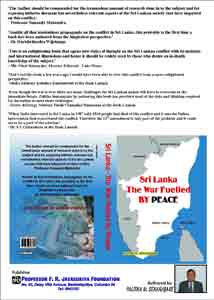Two years after the war, every Tom, Dick and Harry is on a paper trail writing books. On parade are scholars to journalists, politicians to policeman- some placing official records between hard covers with the assistance of spooky wordsmiths.
Coverage at a launch, it appears, is more important than the contents in the book. Keynote speakers are made cabaret artistes if a book is doomed to be dull.
Palitha Senanayake, author of Sri Lanka-The War Fuelled by Peace is not such a Tom, Dick or Harry. He is his own man holding his own ground in a narration of events surrounding a nation engaged in a game of War and Peace spanning three decades. Events are covered vivaciously during both phases without presenting a dumb commentary, which gives it the necessary lift and life, to make you want to read on. It’s a genuinely nationalistic paper- worth a read and a re-read.
 |
At conception time he touches the embryo and takes it on a demographic ride down memory lane and works his way to the nursery situated in schools-‘suave’ or otherwise. The Sri Lanka School makes Sri Lanka Man theory is properly picked and worked on to make it convincing. It runs true to form on the schoolboy but the old boy that runs the evergreen Association sometimes ruins the school and its boys. An old boy is different from days he was an honourable schoolboy. The author does not forget the old boy networks. Such is the reach of the book, targeted with telescopic lenses in the selection of topics and fired relentlessly at the target.
Senanayake writes from the touchlines but has the pulse of the people in his wrist and says “ordinary people in this country whose common sense is not tainted with political dogmas and ‘isms’, always believed that negotiations with Prabhakaran was a national and international disaster from the time of Thimphu”. On President Wijetunga: ‘had the common sense of the ordinary Sinhala villager devoid of western theories to understand the LTTE mentality and their shenanigans’. Not an NGO bloke with an i-pad, the author operates on the same wave band as the former President but stimulatingly entertaining and educated.
A typical southpaw prepared to land a punch where it is most likely to hurt without being called foul, his penetrative insights into the principal characters are intriguing as names surface in the manner they behaved to be petted or punched. It may look remote through a telescope but stands magnified under a microscope. Why was the Director of the Dudley Foundation appointed and by whom? The author becomes a sleuth and takes you on a mystery journey. Many more are on board but wish the author had laboured on them still more, as his conclusions are often right, in hindsight.
Part anecdotal part narrative, fortunately not encyclopedic to kill the vibrancy, the book leaves no quarter untouched. The big picture takes in all comprehensively- India and NGOs, Diaspora and Chandrika, Colombians and Jaffna Tamils, Western Influence and Colonialism. It’s there sandwiched between thought provoking comment.
Twenty chapters is the length Senanayake takes to build a formidable case in his own remarkable style to challenge those who opposed the war and supported a peace agenda beneficial to their selfish lifestyles.
Senanayake holds promise for more writings- a name undoubtedly for literary columns in support of the underdog –that is his beat.
If I have a small bookcase carrying the title ‘war’, this will yet be a must. |


